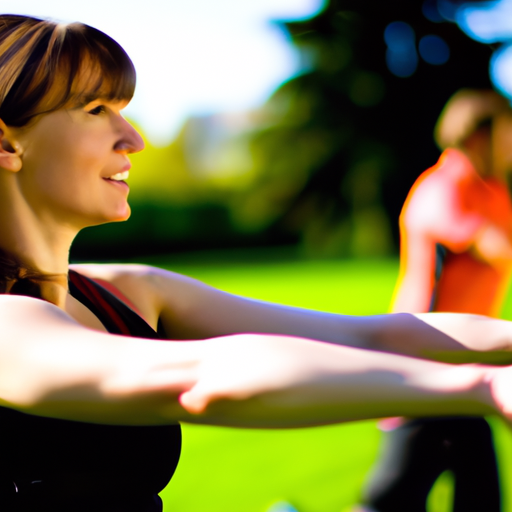Are you new to the world of fitness and not sure where to start? Don’t worry, we’ve got you covered! In this article, we’ll walk you through all the steps you need to take to start a fitness routine as a beginner. Whether you’re looking to lose weight, build muscle, or just improve your overall health, we’ll provide you with the guidance and tips you need to get started on your fitness journey. So, let’s dive in and get moving towards a healthier, happier you!
Curious to know more about how you can begin your fitness routine as a beginner? Well, you’re in luck! In this article, we’ll be discussing the different aspects of starting a fitness routine, including setting realistic goals, finding the right type of exercise for you, and creating a workout schedule that fits into your daily life. We understand that starting out can be intimidating, but with our friendly and supportive guidance, you’ll be well on your way to achieving your fitness goals in no time. Stay tuned and get ready to embark on an exciting journey towards a fitter and stronger version of yourself!

This image is property of pixabay.com.
Setting Goals
Identifying your fitness goals
Before starting a fitness routine, it is essential to identify your fitness goals. This will give you a clear direction and purpose for your workouts. Take some time to think about what you want to achieve through your fitness routine. Perhaps you want to lose weight, build muscle, improve cardiovascular health, or simply feel more energized. Whatever your goals may be, clearly defining them will help you stay motivated and focused throughout your fitness journey.
Setting realistic goals
While it is important to dream big, it is equally important to set realistic goals. Setting unattainable goals can lead to frustration and disappointment, and may even cause you to give up on your fitness routine altogether. Instead, set smaller, achievable goals that can be reached in a specific timeline. For example, if your ultimate goal is to lose 20 pounds, you can set a goal to lose 1-2 pounds per week. This way, you can celebrate small victories along the way and stay motivated to keep going.
Creating a timeline for achieving your goals
Once you have identified your fitness goals and set realistic targets, it is time to create a timeline for achieving them. Having a timeline will help you stay organized and accountable. Break down your goals into smaller milestones and assign specific dates for each milestone. For example, if your goal is to run a 5K race in three months, you can set milestones to increase your running distance gradually over the next few weeks. Having a structured timeline will give you a sense of progression and help you stay on track.
Choosing the Right Exercises
Understanding different types of exercises
Before starting a fitness routine, it is important to understand the different types of exercises available. Exercise can be categorized into three main types: cardiovascular exercise, strength training, and flexibility exercises. Cardiovascular exercises, such as running or cycling, help improve your heart and lung health. Strength training, which includes exercises like weightlifting, helps build muscular strength and endurance. Flexibility exercises, such as stretching or yoga, enhance your mobility and prevent injuries. By incorporating each type of exercise into your fitness routine, you can achieve a well-rounded and balanced workout.
Consulting with a fitness professional
If you are a beginner, it is advisable to consult with a fitness professional, such as a personal trainer or fitness instructor. They can guide you in choosing the right exercises based on your fitness goals, abilities, and any specific health considerations. Additionally, they can teach you the correct form and technique for each exercise, ensuring that you perform them safely and effectively. A fitness professional can also help personalize your workout plan and tailor it to your specific needs and preferences.
Selecting exercises that match your interests and abilities
When starting a fitness routine, it is important to select exercises that you enjoy and that match your abilities. If you enjoy a particular activity, you are more likely to continue doing it consistently. Consider your interests and hobbies when choosing exercises. If you enjoy being outdoors, activities like hiking or swimming could be a great option. If you prefer group activities, joining a fitness class or sports team could be beneficial. By selecting exercises that align with your interests and abilities, you are more likely to stay motivated and make exercise a regular part of your lifestyle.
Creating a Workout Plan
Determining the frequency and duration of your workouts
Once you have chosen the right exercises, it is important to determine the frequency and duration of your workouts. As a beginner, it is recommended to start with three to four workouts per week. This will give your body time to rest and recover between sessions. Gradually increase the duration and intensity of your workouts as your fitness level improves. Aim for at least 30 minutes of exercise per session, gradually increasing to 60 minutes or more as you become more comfortable and fit. Remember, consistency is key, so stick to your workout schedule to see progress.
Structuring your workouts for maximum effectiveness
To make your workouts more effective, it is important to structure them properly. Begin each workout with a warm-up, consisting of some light cardio exercises and dynamic stretches to prepare your muscles for the workout ahead. Then, move on to the main part of your workout, which could include cardiovascular exercises, strength training, and flexibility exercises, depending on your goals. Alternate between different types of exercises to engage different muscle groups and prevent boredom. Finally, end each workout with a cool-down, which may include static stretches to help your muscles recover and prevent post-workout soreness.
Incorporating warm-up and cool-down exercises
When starting a fitness routine, many beginners overlook the importance of warm-up and cool-down exercises. However, these exercises are crucial for injury prevention and optimal performance. Warm-up exercises increase blood flow to your muscles, prepare your cardiovascular system, and loosen your joints, making your workouts safer and more effective. Some examples of warm-up exercises include jogging in place, jumping jacks, or arm circles. Cool-down exercises, on the other hand, help your body gradually return to its resting state and prevent muscle soreness. Stretching exercises, such as toe touches or quad stretches, can be included in your cool-down routine.
Starting Slowly
Avoiding overexertion and injuries
As a beginner, it is important to start slowly and avoid overexertion. Pushing yourself too hard too soon can lead to injuries and burnout, which will only hinder your progress. Listen to your body and give yourself time to adapt to your new fitness routine. If you feel excessively fatigued or experience pain, take a break and rest. Increase the intensity and duration of your workouts gradually, allowing your body to adjust and build strength over time.
Progressing gradually as you build strength and stamina
As you gain strength and stamina, it is important to progress gradually in your fitness routine. Challenge yourself by increasing the intensity, duration, or frequency of your workouts every few weeks. This progression will help you avoid plateaus and continue seeing results. For example, if you have been walking for exercise, you can gradually increase your pace or add short intervals of jogging. By pushing yourself slightly outside of your comfort zone, you will continue to improve and make progress towards your fitness goals.
Listening to your body and adjusting your routine accordingly
One of the most important aspects of starting a fitness routine is to listen to your body and adjust your routine accordingly. Pay attention to how your body feels during and after workouts. If you consistently feel tired or experience discomfort, it may be a sign that you need to adjust your routine or incorporate more rest days. On the other hand, if you feel energized and motivated, you can consider increasing the intensity or duration of your workouts. Your body is unique, so it is essential to personalize your routine to suit your needs and abilities.

This image is property of pixabay.com.
Finding Motivation
Identifying your reasons for starting a fitness routine
Finding motivation to start and stick to a fitness routine can be challenging, especially as a beginner. One way to stay motivated is by identifying your reasons for starting a fitness routine in the first place. Whether it is to improve your health, boost your confidence, or reduce stress, remind yourself of these reasons whenever you feel demotivated. By connecting with your underlying motivations, you will find the inner drive to keep going even when it gets tough.
Creating a support system
Having a support system can significantly impact your motivation and accountability. Share your fitness goals with family and friends and ask for their support. You can even find a workout buddy who shares similar goals and can join you in your fitness journey. Having someone to exercise with can make workouts more enjoyable and help you stay committed. Additionally, consider joining fitness classes or groups where you can meet like-minded individuals who can provide encouragement and support.
Tracking your progress and celebrating milestones
Tracking your progress and celebrating milestones can be incredibly motivating. Keep a record of your workouts, noting the exercises, duration, and any personal achievements. This will not only help you visualize your progress but also serve as a reminder of how far you have come. Celebrate each milestone you achieve, whether it is running an extra mile, lifting heavier weights, or fitting into smaller clothes. Remember, progress may be slow, but any progress is worth celebrating.
Forming Healthy Habits
Prioritizing consistency over intensity
When starting a fitness routine, it is important to prioritize consistency over intensity. Building a habit takes time, and focusing on exercising regularly is more important than going all-out for a short period of time. Aim for consistency in your workouts, even if they are short and less intense initially. By making exercise a regular part of your routine, it will become a habit that will eventually feel natural and effortless.
Scheduling regular workout sessions
To ensure consistency, it is helpful to schedule regular workout sessions. Treat your exercise time as an important appointment with yourself and prioritize it. Choose a time of day that works best for you and commit to it. This will help you establish a routine and make it easier to stick to your fitness goals. Remember, even if you can’t dedicate a full hour to exercise, shorter sessions are still beneficial. Consistency is key.
Making time for rest and recovery
Rest and recovery are just as important as exercise itself. Your body needs time to repair and rebuild after intense workouts. Make sure to incorporate rest days into your fitness routine to allow your muscles to recover and prevent overtraining. Listen to your body and give yourself permission to rest when needed. Remember, rest is not a sign of weakness but an essential component of any successful fitness routine.

This image is property of pixabay.com.
Staying Accountable
Finding a workout buddy
Having a workout buddy can significantly increase your accountability and motivation. Find a friend, family member, or colleague who shares similar fitness goals and commit to exercising together. Knowing that someone is counting on you to show up can make it harder to skip workouts. Plus, having a workout buddy can make exercise more enjoyable and provide an opportunity for social interaction.
Joining fitness classes or groups
If finding a workout buddy is challenging, consider joining fitness classes or groups. Many gyms and community centers offer a variety of classes, from yoga to Zumba, that cater to different fitness levels. By joining these classes, you will not only receive professional guidance but also become part of a supportive community. The group dynamic and the camaraderie can boost your motivation and hold you accountable.
Using fitness tracking apps or journals
In today’s digital age, there are numerous fitness tracking apps and journals available that can help you stay accountable. These apps can track your workouts, provide personalized training plans, and even offer reminders to exercise. Choose one that aligns with your goals and preferences and use it to log your workouts and monitor your progress. The visual representation of your progress can be highly motivating and help you stay on track.
Seeking Professional Guidance
Consulting a healthcare professional before starting a fitness routine
Before starting a fitness routine, particularly if you have any underlying health conditions or concerns, it is essential to consult a healthcare professional. They can assess your current health status and provide guidance on which exercises are safe and appropriate for you. Additionally, they can address any specific concerns you may have, such as managing chronic conditions or accommodating physical limitations. Their expertise and guidance will ensure that you embark on your fitness journey safely and effectively.
Hiring a personal trainer or coach
If you want personalized guidance and support throughout your fitness journey, consider hiring a personal trainer or fitness coach. They can tailor a workout plan specifically to your goals, abilities, and preferences. A personal trainer can provide correct form and technique, prevent injuries, and help you stay motivated. They can also track your progress and make adjustments to your routine as needed. Investing in a personal trainer can significantly enhance your fitness experience and ensure you achieve optimal results.
Taking advantage of available resources and expertise
Even if you choose not to hire a personal trainer, there are still plenty of resources and expertise available to help you start a fitness routine. Take advantage of online tutorials, instructional videos, and reputable fitness websites that offer guidance and tips for beginners. Educate yourself on proper form, technique, and safety precautions to prevent injuries. By equipping yourself with knowledge, you can approach your workouts with confidence and make informed decisions.

Overcoming Challenges
Dealing with setbacks and plateaus
It is important to acknowledge that setbacks and plateaus are a normal part of any fitness journey. There will be days when you feel demotivated or when progress seems slow. During these times, it is crucial to stay patient and not give up. Remind yourself of how far you have come and stay focused on your long-term goals. Seek support from your support system, whether it is your workout buddy, friends, or family. They can provide encouragement and help you navigate through challenges.
Managing workout-related discomfort or fatigue
As a beginner, you may experience discomfort or fatigue during and after workouts. This is normal and can be managed with proper rest and recovery. Make sure to listen to your body and incorporate rest days into your routine. Engage in activities that promote recovery, such as foam rolling, stretching, or taking a warm bath. It is also essential to fuel your body with nutritious food to provide the energy and nutrients it needs to recover. If any discomfort persists or worsens, consult a healthcare professional for further evaluation.
Adapting your routine to fit your lifestyle
Life can be unpredictable, and it is important to be flexible and adapt your fitness routine to fit your lifestyle. If you find it challenging to stick to a rigid workout schedule, find alternative ways to incorporate physical activity throughout your day. Take the stairs instead of the elevator, walk or bike to work if feasible, or engage in active hobbies such as gardening or dancing. Remember, every movement counts, and finding ways to be active throughout the day can make a significant impact on your fitness journey.
Conclusion
Starting a fitness routine as a beginner may seem daunting, but with the right mindset, guidance, and support, it is an achievable goal. By setting realistic goals, choosing the right exercises, creating a workout plan, starting slowly, finding motivation, forming healthy habits, staying accountable, seeking professional guidance, and overcoming challenges, you can embark on a successful fitness journey. Remember to be patient with yourself, celebrate small victories along the way, and enjoy the process of becoming a healthier, fitter version of yourself. So lace up those sneakers, take that first step, and discover the amazing benefits of a regular fitness routine. Your body and mind will thank you.


